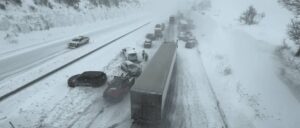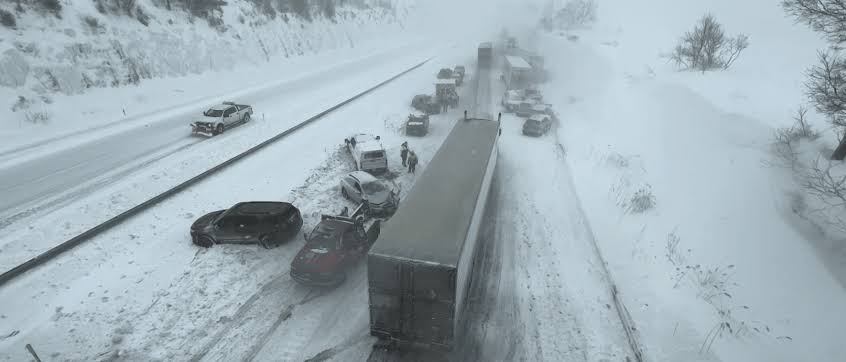Niagara,Whiteouts cause head-on collisions as wind persists
Whiteouts Cause Head-On Collisions as Wind Persists
Great Plains Region, USA
A series of dangerous whiteout conditions across the Great Plains has led to multiple head-on collisions, as powerful winds continue to sweep through the region. Emergency services are on high alert, responding to a growing number of traffic accidents amid near-zero visibility and treacherous road conditions.
According to the National Weather Service (NWS), wind gusts exceeding 60 miles per hour have kicked up large amounts of snow and loose powder, creating sudden and extreme visibility reductions known as whiteouts. These conditions have blanketed highways across Nebraska, South Dakota, and parts of Iowa and Kansas since early Wednesday morning, leading to significant travel disruptions and public safety concerns.
Dangerous Driving Conditions
Highway patrol officers from several affected states have reported a sharp uptick in accidents, particularly head-
“This is one of the most hazardous winter events we’ve dealt with in years,” said Sgt. Leo Richardson of the Nebraska State Patrol. “People can’t see more than a few feet ahead, and when you combine that with high-speed winds and icy roads, it becomes a recipe for disaster.”
In total, at least 48 crashes were reported by Wednesday evening, 15 of which were head-on collisions. Several interstates, including I-80 and I-29, have been partially closed or are under travel advisories, with authorities urging drivers to stay off the roads entirely unless absolutely necessary.
Causes and Compounding Factors
Meteorologists explain that whiteouts occur when wind lifts snow from the ground and keeps it suspended in the air, reducing visibility to near zero. What makes this event especially dangerous is the persistence of the wind — sustained speeds of 40 to 50 mph with gusts over 60 mph — prolonging the whiteout conditions for hours on end.
“This isn’t just a passing squall,” said Linda Martinez, a meteorologist with the NWS office in Sioux Falls. “The wind is relentless, and we’re seeing snow picked up and carried across vast distances. It’s not just the falling snow; it’s the blowing snow that’s making conditions so hazardous.”
Complicating matters, the spring thaw had already begun in some regions, leaving roads slick and partially refrozen. This combination of factors has created conditions where stopping distances are increased, and drivers may overcorrect or drift across center lines without realizing it.
Impact on Emergency Response
The conditions have hampered emergency response efforts, with ambulances and tow trucks struggling to reach crash sites. In some rural areas, crews have had to be escorted by snowplows or even wait for winds to subside before proceeding.
“We’ve had cases where first responders were unable to find the accident scenes right away,” said Emily Chong, a spokesperson for the South Dakota Department of Public Safety. “The GPS says they’re within 100 feet, but they can’t see a thing in front of them.”
Helicopter evacuation was ruled out for most of the day due to the wind speeds and poor visibility. Hospitals in several counties have been placed on standby to receive multiple trauma patients at a time.
Public Advisory and School Closures
As the storm system shows no sign of easing, schools across more than 50 districts in the affected states canceled classes. Authorities issued strong advisories for residents to remain indoors and avoid all non-essential travel.
Local officials are also warning about the risk of secondary hazards, such as power outages and frostbite. With temperatures dropping and winds increasing the chill factor, exposed skin can become frostbitten in under 10 minutes.
“We urge people to prepare for possible outages and keep extra blankets, flashlights, and food on hand,” said Governor Caroline McAdams of South Dakota in an emergency briefing. “Do not venture outside unless it is absolutely critical.”
Trucking and Supply Chain Impacts
The Great Plains region is a critical corridor for freight transport, and the storm has caused significant delays and detours in long-haul trucking routes. Several major logistics companies have suspended operations temporarily or rerouted vehicles to avoid the worst-affected areas.
“Safety of our drivers is our top priority,” said Andrew Reilly, director of operations at Midwest Freight Lines. “We’re working closely with authorities to monitor conditions and will resume service only when it’s safe.”
The backlog of delayed deliveries is expected to impact supply chains across the Midwest, especially for perishable goods and fuel shipments. Fuel trucks have had to pause operations, raising concerns in smaller communities where fuel supplies are already tight.
Looking Ahead
The NWS forecasts that the winds may begin to subside late Thursday evening, but warn that drifting snow and residual whiteout pockets could linger into Friday. Cleanup efforts will begin once conditions allow, though authorities expect it could take several days to clear all affected roadways.
In the meantime, state and local governments have opened emergency warming shelters in rural communities, offering refuge to stranded travelers and vulnerable residents.
Experts are using the event to highlight the importance of winter weather preparedness, especially during what many assume to be the “tail end” of the season.
“Spring may be on the calendar, but winter still has a firm grip on the Plains,” said Martinez. “This event is a sobering reminder that extreme weather doesn’t always respect seasonal boundaries.”
Final Word
As wind-driven snow continues to cause whiteouts across the region, emergency officials stress the importance of caution, preparation, and awareness. With several lives already lost and dozens more injured, the ongoing storm has become one of the most severe late-season winter weather events in recent memory.
Authorities will continue to monitor the situation closely and provide updates as the weather evolves. For now, the message remains simple: Stay home. Stay safe.
—






